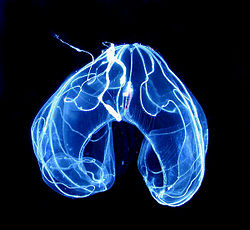| Bathocyroe fosteri | |
|---|---|
 | |
| Scientific classification | |
| Domain: | Eukaryota |
| Kingdom: | Animalia |
| Phylum: | Ctenophora |
| Class: | Tentaculata |
| Order: | Lobata |
| Family: | Bathocyroidae |
| Genus: | Bathocyroe |
| Species: | B. fosteri |
| Binomial name | |
| Bathocyroe fosteri L.P. Madin and G.R. Harbison, 1978 | |
Bathocyroe fosteri is a species of lobate ctenophore found at intermediate depths in all the world's oceans. [1] The species is very common and abundant near the Mid-Atlantic Ridge. It is bioluminescent, and is typically observed hanging motionlessly in an upright or inverted posture although it can flap its oral lobes to swim. [2] This deep-sea comb jelly is named for Alvin (DSV-2) pilot Dudley Foster, who collected the first specimens.